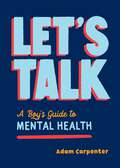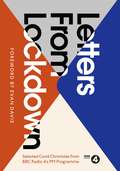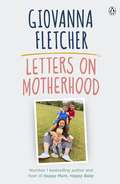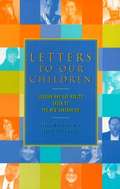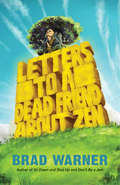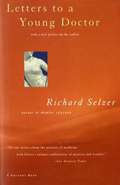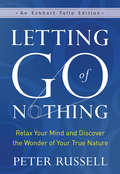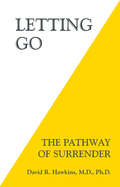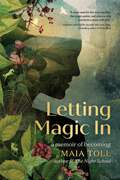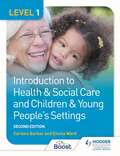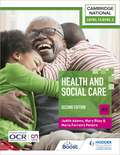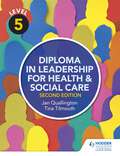- Table View
- List View
Let's Talk About The Problem Of AIDS
by Pete A. Sanders Clare FarquharA beginner book to help children begin to understand about AIDS and how it is spread, and how it is not spread.
Let's Talk About When Someone You Love Has Alzheimer's Disease
by Elizabeth WeizmanA simple, factual book that talks about what will happen when someone a child loves has this degenerative disease. Very matter of fact and very much on a kids level.
Let's Talk: A Boy's Guide to Mental Health
by Adam CarpenterAn invaluable tool to get boys talking Talking costs nothing but it can change your life for the betterGrowing up is hard work! You’re expected to ace your exams, be responsible, keep up a hectic social life both online and IRL, make big decisions about your future, and somehow stay happy at the same time. But, as we know, no one feels OK all the time, so what happens then? What happens when we don’t feel great and don’t know what to do about it or where to get help?Let’s Talk provides the tools to get boys talking about how they’re feeling. Within this insightful guide you will find activities to figure out what help you might need, advice on where to get help, and case studies to show how others have voiced their feelings and found help.Learn to:Articulate how you’re feelingBuild a support networkCreate your own well-being toolkitBounce back from low moodHelp others who might be strugglingRemember: if you’re not feeling OK, you have the power to do something about it and this book will show you how.
Let's Talk: A Boy's Guide to Mental Health
by Adam CarpenterAn invaluable tool to get boys talking Talking costs nothing but it can change your life for the betterGrowing up is hard work! You’re expected to ace your exams, be responsible, keep up a hectic social life both online and IRL, make big decisions about your future, and somehow stay happy at the same time. But, as we know, no one feels OK all the time, so what happens then? What happens when we don’t feel great and don’t know what to do about it or where to get help?Let’s Talk provides the tools to get boys talking about how they’re feeling. Within this insightful guide you will find activities to figure out what help you might need, advice on where to get help, and case studies to show how others have voiced their feelings and found help.Learn to:Articulate how you’re feelingBuild a support networkCreate your own well-being toolkitBounce back from low moodHelp others who might be strugglingRemember: if you’re not feeling OK, you have the power to do something about it and this book will show you how.
Letters from Lockdown: A Selection of Covid Chronicles from BBC Radio 4’s PM Programme
by Evan DavisA remarkable collection of 'Covid Chronicles' -- stories from lockdown sent in from listeners to BBC Radio 4 -- making a deeply moving people's history of the pandemic. On 23 March 2020, as the deadly virus spread around the world, the UK went into lockdown. In the following weeks and months, it became clear that in many ways we were all in this together, but the illness and the long period of isolation would hit people in entirely different ways.When BBC Radio 4's PM Programme launched the 'Covid Chronicles' series, listeners from across the country - and beyond - began sending in their lockdown stories to be aired on the show. The results are astonishing: moving, profound, funny, powerful and an invaluable record of our collective experiences. Ranging from the everyday (the thrill of booking a food delivery) to the momentous (a wedding on Zoom), we hear about birth and death, loneliness and loss, community and kindness, as well as remarkable stories from those working in the NHS on the front line.This book is a collection of some of these Chronicles, written in the midst of one of the most unexpected and intense moments in our history. Together they give us an unforgettable portrait of ordinary people caught in extraordinary times, with all the humour and tragedy and uncertainty we've been through. 'It's inspiring that so many people have shared their stories - some everyday, some life-changing, but all very human. This is a wonderful collection of experiences, to record and remember this devastating year' Christie Watson, bestselling author of The Language of Kindness
Letters from a Distant Shore
by Marie Lawson FialaTragedy shattered Marie Lawson Fiala's life as wife, mother and lawyer when her 13-year old son, Jeremy, was felled by a massive hemorrhage from a ruptured artery deep in his brain. Within an hour, Jeremy was in a coma, sustained only by machines. This memoir of a mother's ferocious care, devastating loss and prayerful transcendence focuses on bringing her son back from the edge. The suspense is relentless and the author's observations as sharp as a scalpel.
Letters from the Yoga Masters: Teachings Revealed through Correspondence from Paramhansa Yogananda, Ramana Maharshi, Swami Sivananda, and Others
by Paramhansa Yogananda Erich Schiffmann Ramana Maharshi Marion Mugs Mcconnell Swami SivanandaThis intimate and insightful account of the life of Dr. Harry (Hari) Dickman, referred to by Swami Sivananda as "the yogi of the West," features more than fifty years of correspondence between Dickman and well-known yoga masters such as Swami Sivananda, Ramana Maharshi, Paramhansa Yogananda, and almost one hundred others. Marion (Mugs) McConnell, Dickman's student, has created a brilliant and loving tribute to her teacher, who founded the Latvian Yoga Society in the early 1930s and later spread his knowledge in the U.S. with the blessings of Paramhansa Yogananda, author of Autobiography of a Yogi. Offering a broad range of information on yoga history, theory, and techniques from a variety of different paths, Letters from the Yoga Masters contains a treasure trove of previously unavailable material and presents detailed teachings about pranayama, mudras, diet, and much more, all interwoven with stories and personal anecdotes. Taken together, the rare correspondence and personal chronicles provide an unparalleled glimpse into the life of a yogi, the development of yoga in the West, and the ways that spiritual wealth is disseminated across generations.From the Trade Paperback edition.
Letters on Motherhood: The heartwarming and inspiring collection of letters perfect for Mother’s Day
by Giovanna FletcherThe heartwarming letters from Giovanna to her husband Tom Fletcher, their three sons, and mothers everywhere - from the bestselling author and host of the No. 1 Happy Mum Happy Baby podcast'Inspiring, beautiful and eye opening. Thank you Giovanna. You've made many mothers feel like they're not alone' 5***** Reader Review'As heartwarming as it is moving' Hello!NOW WITH FOUR EXCLUSIVE NEW LETTERS_______With stories parents everywhere can relate to, Giovanna writes beautiful, poignant and deeply heartfelt letters to everyone who has helped her to become the mother she is today. To her young sons: Buzz, Buddy and Max. To Tom, and her mum and dad. But also, to herself, her body, and more. And finally, to all of the mums, dads and mums-to-be out there doing the work too. These letters cover everything from her fears and hopes to the love and uncertainty of being a mother today. Honest, heartwarming and hilarious, Giovanna's relatable musings on motherhood are both a joy and a comfort, paying testament to the power of family._______'Fantastically honest, witty and real . . . I laughed and cried!' 5***** Reader Review'Giovanna is a real one' Candice Brathwaite, bestselling author of I Am Not Your Baby Mother'Cried, laughed and could relate to nearly every word' 5***** Reader Review'Giovanna is a one of a kind sort of person. She's genuine, talented, and well honestly? I just really like her' Rosie Ramsay, bestselling author of Sh**ged. Married. Annoyed.
Letters to Benvenuta
by Rainer Maria RilkeThis collection of letters by the renowned Austrian poet offers a rare glimpse into his private life and his relationship with the woman he called Benvenuta.In January of 1914, Rainer Maria Rilke received his first letter from a Viennese correspondent who had discovered his story collection, Tales of the Dear Lord God. A sudden and intense exchange of letters followed which would eventually put the famous poet in touch with the woman he would never meet. Nearing forty and separated from his wife, Rilke was ill and depressed when his correspondence with Magda von Hattingberg began. A concert pianist many years younger, she was also alone. Von Hattingberg told the story of their brief but dramatic attachment in her book Rilke and Benvenuta. Now their story is made complete with Letters to Benvenuta, a series of letters written by Rilke during a sojourn in Paris.
Letters to Missy Violet
by Barbara HathawayA heartwarming coming-of-age story set in the rural South. With her friend Missy Violet away in Florida, Viney has big shoes to fill. While there are ailing neighbors to comfort, Viney's favorite teacher has left school--and Viney's irrepressible cousin Charles continues his mischief-making. Through short, powerful vignettes and letters between Missy Violet, Viney, and others, the day-to-day happenings in this warm southern town come to life.
Letters to Misty: How to Move Through Life with Confidence and Grace
by Misty CopelandNew York Times bestselling author and first black female American Ballet Theatre principal dancer Misty Copeland offers advice for on and off the dance floor to young readers based on letters she&’s received over the years from fans.As the first African American principal female dancer at American Ballet Theatre, Misty Copeland has spent most of her career navigating a white-dominated industry that puts many barriers in her path. Through it all, Misty has credited the many mentors who have helped her become the dancer and person she is today. With Misty&’s profile now at peak heights, she has now found herself in a mentor role herself, often asked for advice on everything from dance-specific questions to life lessons about being the &“other&” in certain spaces by her fans. As Misty herself has said, &“I think it&’s really important to have a community around you, a support system, mentors, people that are going to be there for you on those days when you just aren&’t strong enough to do it yourself.&” Given that philosophy, Misty is thrilled to bring this book of advice to life, covering everything from body confidence to balancing various commitments and how to break out of your comfort zone. Each section includes personal anecdotes from Misty about the topic that bring her perspective to life.
Letters to Momo: A Remarkable Story About the Power to Overcome
by Alejandro SouzaIn September 2010, Alejandro Souza learned that Momo, his cousin and closest friend in the family, was suddenly imprisoned. Crushed by his imprisonment and desiring to infuse him with strength, resilience, and, above all, love, Souza made an unconditional commitment to write Momo one letter each day for as long as he was in jail. Letters to Momo is the true, remarkable story about the power to overcome told by the collection of all letters written to Momo during his 144 days in prison—intact and in their original state, exactly as he received them. Uniquely sincere and approachable, the letters&’ contemplative style illuminates core truths about the human experience and invites all to engage in profound reflection. Through broad thematic examinations spanning from personal experiences to Persian poetry, and from Nietzsche to cognitive psychology, the letters&’ inspirational tone leads you away from the traps of victimhood to reclaim the innate power to author change in your life. With the closing words of each letter, "I love you with all my heart, and today, let me walk with you,&” Souza holds our hearts and hands as we embark on our own journey of personal resilience, transcendence, and freedom. Today let these letters walk with you.
Letters to Our Children: Lesbian and Gay Adults Speak to the New Generation
by Larry Dane BrimnerGay men and lesbians from all walks of life describe their personal experiences, travails and triumphs.
Letters to a Dead Friend about Zen
by Brad WarnerThe night Brad Warner learns that his childhood friend Marky has died, Warner is about to speak to a group of Zen students in Hamburg, Germany. It’s the last thing he feels like doing. What he wants to do instead is tell his friend everything he never said, to explain Zen and what he does for a living and why he spends his time “Sitting. Sitting. Sitting. Meditating my life away as it all passes by. Lighting candles and incense. Bowing to nothing.” So, as he continues his teaching tour through Europe, he writes to his friend all the things he wishes he had said. Simply and humorously, he reflects on why Zen provided him a lifeline in a difficult world. He explores grief, attachment, and the afterlife. He writes to Marky, “I’m not all that interested in Buddhism. I’m much more interested in what is true,” and then proceeds to poke and prod at that truth. The result for readers is a singular and winning meditation on Zen — and a unique tribute to both a life lost and the one Warner has found.
Letters to a Young Doctor
by Richard SelzerHighly candid, insightful, and unexpectedly humorous essays on both the brutality and the beauty of the profession in which saving and losing lives is all in a day's work. A timeless collection by the best of the writing surgeons.
Letters to my Fanny
by Cherry HealeyHow much more fun in life could I have had if I'd just stopped worrying so much and stopped beating myself up?In this book, Cherry reveals the things she wishes her mother had told her, through a series of hilarious anecdotes and excruciating confessions.Each chapter opens with a letter to a different body part: 'Letters to my Fanny' covers sex, orgasms and periods; 'Letters to my Brain' covers education, memory and media; 'Letters to my Tummy' covers crop-tops, pregnancy and sit-ups.This wonderfully warm, funny and candid book is a collection of hopeful dispatches from the frontline of girlhood - an impassioned plea to stop piling pressure on girls and young women and allow them to get on with their lives without having to mind the thigh gap . . .
Letting Go of Nothing: Relax Your Mind and Discover the Wonder of Your True Nature (An Eckhart Tolle Edition)
by Peter RussellA practical and empowering approach to the age-old quest to let go of the thoughts and feelings that block happiness, impede change, and hinder self-acceptance Anyone who has dipped a toe into any of the world&’s spiritual traditions knows that letting go and letting be are key. But how? In this fresh, frank, and powerful guide, Peter Russell allows readers to see that the things we get hung up on are generally not tangible problems in the present, but are instead thoughts, feelings, interpretations, beliefs, or expectations we have about them. These are not actual things; they exist only in our minds. And we can strip these &“no-things&” of their power and let them go by making a simple change of mind. Russell boils this letting go down to remarkably easy methods of accepting, acknowledging, recognizing, and even befriending what we tend to run from. This paradoxical practice generates peace of mind, fresh perspectives, and wisdom in action. In turbulent times like ours, this is a true power, one available to us all.
Letting Go: The Pathway Of Surrender
by David R. HawkinsThe present work describes a simple and effective means by which to let go of the obstacles to Enlightenment and become free of negativity. During the many decades of the author's clinical psychiatric practice, the primary aim was to seek the most effective ways to relieve human suffering in all its many forms. The letting go technique (surrender) was found to be of great practical benefit and is described in this book.
Letting Magic In: A Memoir of Becoming
by Maia TollFrom Maia Toll, the best-selling author of the Wild Wisdom series and The Night School, comes the enchanted story of her own magical awakening, a journey from Brooklyn to Ireland that will inspire readers to uncover their own inner magic. "Toll focuses on her own winding path, one that will resonate with seekers." — People What is the word for craving a relationship with the earth, plants, rocks, and stars? What do you call someone who finds their spirit sparked by these relationships; whose concept of the sacred is altered by the scent of jasmine in bloom or the deep indigo of a sky awaiting nightfall? We&’re taught that doctors know our bodies and priests know our souls. But what if you&’re a person seeking to understand both for yourself without an intermediary? What is the word for these feelings and the person we become when we honor them? For writer Maia Toll, that word is magic. Magic points to something intrinsic to, and necessary for, the wholeness of the human spirit. It&’s a marker for the gnawing craving for a connection which includes, but also stretches beyond, the human realm. The exploration of this word was part of her search for both personal empowerment and a sense of cosmic connectedness, the yin and yang of our lives. In Letting Magic In Maia shares the story of her own magical becoming—from the untimely death of a friend that leads her to abandon Brooklyn in favor of the small town of Beacon, NY, to taking a yearlong sabbatical of exploration, and finally to Ireland, where she studied under an herbalist and learned the true magic of listening to the earth itself. This book is the story of one woman's becoming—the story of pushing past the boundaries of what once seemed possible to discover the extraordinary all around us. In it Maia shares how she learned to let magic in so she could live the life she longed for—one filled with curiosity, connection, and the deepest kind of inner knowing. In this soulfully written recollection—peppered throughout with magical learnings and rituals gathered along the way—Maia uncovers the things that change you in unexpected ways and guide you to become the person you never knew you wanted to be, but perhaps, always were. This she could call magic. And through Letting Magic In you will gain the courage and the wisdom to find your own.
Levante Para O Sucesso: Aumente Sua Energia E Alcance Objetivos Com Uma Rotina Matinal
by Mayara Leal S. J. ScottDESCUBRA:: Por que pessoas bem-sucedidas realizam mais coisas antes das 9h.Você está com dificuldade para alcançar seus objetivos? A razão pela qual a maioria das pessoas não são bem-sucedidas é que elas não conseguem seguir uma estratégia dia após dia. Em vez disso, elas começam cada dia "esperando" ter tempo suficiente para agir com relação aos seus objetivos.Se você examinar de perto, as pessoas mais bem-sucedidas do mundo começam cada dia em um estado energizado, prontas para realizar qualquer objetivo. Qual é o segredo delas? Aquela *coisa* que elas fazem diferente é priorizar cada dia de uma forma que a tarefa mais importante seja completada primeiro. Simplificando: as pessoas bem-sucedidas têm rotinas matinais que as ajudam a se sentir energizadas e prontas para se concentrar em seu objetivo mais importante.COMECE HOJE:: Viva cada dia como se fosse o últimoEm "Levante para o Sucesso", você vai aprender a viver cada dia como se fosse o último. Você não vai mais se arrastar para fora da cama e desperdiçar as primeiras horas. Em vez disso, você vai aprender como começar o dia criando uma energia que será aproveitada ao se concentrar em UM objetivo inovador que vá fazer a diferença em sua vida.Uma rotina matinal é simples e eficaz. Ela é fácil de ser adaptada às suas circunstâncias e metas específicas. E o melhor de tudo: ela foi testada. Dentro deste livro, você vai descobrir estratégias comprovadas para ajudá-lo a tirar o máximo proveito dessas preciosas primeiras horas.BAIXE:: Levante para o Sucesso - Aumente sua energia e alcance objetivos com uma rotina matinal Levante para o Sucesso contém um plano passo a passo para a criação de um ritual matinal poderoso.Dentro deste guia, você vai aprender a:** Criar uma rotina noturna que o prepare para uma manhã energizada** Utilizar 25 dicas para ter uma n
Level 1 Introduction to Health & Social Care and Children & Young People's Settings, Second Edition
by Corinne Barker Emma WardMake real progress with the brand-new, updated edition of this introductory guide.Written in easy-to-read language, this guide has a refreshed design, updated tasks and activities, and a focus on matching and signposting the specification.Suitable for all awarding bodies and written by experts, it will reflect the most recent legislation presented in a colourful design with helpful images to ensure the relevant knowledge is easily accessed.- Now includes addidional five optional units- Clear signposting to the qualification specification criteria- Updated legislation included and explained- New tasks and activities
Level 1 Introduction to Health & Social Care and Children & Young People's Settings, Second Edition
by Corinne Barker Emma WardMake real progress with the brand-new, updated edition of this introductory guide. Written in easy-to-read language, this guide has a refreshed design, updated tasks and activities, and a focus on matching and signposting the specification.Suitable for all awarding bodies and written by experts, it will reflect the most recent legislation presented in a colourful design with helpful images to ensure the relevant knowledge is easily accessed.- Now includes addidional five optional units- Clear signposting to the qualification specification criteria- Updated legislation included and explained- New tasks and activities
Level 1/Level 2 Cambridge National in Health & Social Care (J835): Second Edition
by Maria Ferreiro Peteiro Mary Riley Judith AdamsTrust highly experienced authors, Judith Adams, Maria Ferreiro Peterio and Mary Riley to guide your students through the redeveloped Cambridge National Level 1/Level 2 in Health & Social Care (for first teaching in September 2022). This brand-new edition will strengthen your students' understanding of the content and boost the skills required to tackle the NEA with confidence.This Student Textbook is: > Comprehensive - gain in-depth knowledge of the examined units with clear explanations of every concept and topic, plus improve understanding of the non-examined units with easy-to-follow chapters. > Accessible, reliable and trusted - structured to match the specification and provide the information required to build knowledge, understanding and skills. > Designed to support you - boost confidence when tackling the internal and external assessment with plenty of activities to test and consolidate knowledge. > The go-to guide - expert authors have carefully designed tasks and activities to build skillset in order to aid progression and questions to assess understanding.
Level 1/Level 2 Cambridge National in Health & Social Care (J835): Second Edition
by Maria Ferreiro Peteiro Mary Riley Judith AdamsTrust highly experienced authors, Judith Adams, Maria Ferreiro Peterio and Mary Riley to guide your students through the redeveloped Cambridge National Level 1/Level 2 in Health & Social Care (for first teaching in September 2022). This brand-new edition will strengthen your students' understanding of the content and boost the skills required to tackle the NEA with confidence.This Student Textbook is: > Comprehensive - gain in-depth knowledge of the examined units with clear explanations of every concept and topic, plus improve understanding of the non-examined units with easy-to-follow chapters. > Accessible, reliable and trusted - structured to match the specification and provide the information required to build knowledge, understanding and skills. > Designed to support you - boost confidence when tackling the internal and external assessment with plenty of activities to test and consolidate knowledge. > The go-to guide - expert authors have carefully designed tasks and activities to build skillset in order to aid progression and questions to assess understanding.
Level 5 Diploma in Leadership for Health and Social Care 2nd Edition
by Tina Tilmouth Jan QuallingtonReflect on how best practice can be managed in care settings, develop your leadership skills and achieve your career goals with this new edition of Level 5 Diploma in Leadership for Health and Social Care.This new edition of Level 5 Diploma in Leadership for Health and Social Care has been fully updated to reflect the changes to the structure of the qualification. Covering all of the mandatory units in an easy-to-follow and thorough manner, this book is perfect for anyone looking to progress in their management career and for existing care setting managers as an invaluable reference guide. -Covers all the information in the qualification thoroughly and in an easy to follow manner with a new and updated design.-Updated to match the Level 5 qualification's integration into the higher apprenticeship programme including the new 'undertake a research project' unit.-Encourage learners to think more about the theory aspect of the qualification and how it is applied in the workplace with 'In Practice' features.-Explore and understand the different methods of assessment and how to prepare using relevant activities.

